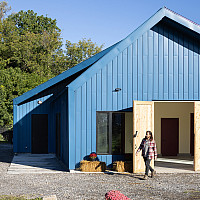Advisor: Junho Chun
We live in a world with a finite supply of natural resources, yet our society continues its destructive usage of these resources, and generation of waste productions such as gas emission, resulting in reduced biological diversity, global warming, and climate changes. In light of this globally shared concern, sustainability has become one of the most important challenges for the building and construction industry, considered as the use of natural resources while maintaining equilibrium conditions, to be maintained and passed down to the next generation. As an architect or engineer, we cannot be detached from cornerstone research on sustainable building materials, phase change materials, additive manufactured (architectured) metamaterials, recycling, reuse of industrial wastes, CO2 emission reduction, and energy conservations. Resilience is a strategy to enhance the ability/performance of a building, infrastructure, or community to recover from damage particularly caused by natural hazards. Architectural and structural design strategies need to increase sustainability, incorporate resourcefulness, and plan for effective recovery of functionality in case of a failure event. To that end, our limited resources must be shared through multidisciplinary considerations across technical, theoretical, and numerical aspects and approach for environmentally responsible and sustainable achievement. This comprehensive design philosophy continues to evolve and grow, as a welcomed phenomenon accepted by engineers, architects, and research communities alike.
We are living in an era where new technologies emerge such as additive manufacturing. Beyond conventional construction materials, new types of materials engineered at micro/macro scale can be explored as alternatives or co-using ones with additive manufacturing which can address architectural and structural design interests. For instance, metamaterials, artificially engineered materials, consist of periodic lattice structures and are designed to have unique properties extending generally beyond mechanical, thermal, and acoustic domain of conventional materials (e.g., negative elasticity, bulk modulus, thermal expansion coefficient, and Poisson’s ratio). Advances in digital design and additive manufacturing have enabled engineers and architects to create diverse geometries with numerous material options. This provides a unique opportunity for novel design solutions with improved sustainability and integrity of infrastructure. Sharing knowledge and interests gleaned from multidiscipline would facilitate the identification of additively manufactured materials and wisely use it with the limited resource in building industries towards sustainability and resilience. It is worthy for us to explore the possibility of past, current and near future resources through recycling, optimization, and emerging technologies within the shared domain of design.
Thesis students are encouraged to consider the history of meta-material development in disciplines including, architecture, structural and mechanical engineering, and urban development, considering the shared characteristics and functionality. The research-design projects will investigate the current state-of-the art, trends, limitations across diverse fields to expand our understanding of this additive material to be applied to the development of new material to increase the resilience of building and imagine re-using of refuse material to enhance sustainability.
tuesday, may 2, 10 am - 3:40 PM, room 101
Internal Critics: Godlewski, Memaran Dadgar, Kerner, Mac Namara
| 10:00 AM |
Shangkun James Zhong Linear Waltz with Nature |
| 10:50 AM |
Nayan Helen Dong & Huiyang Gong VR-Assisted Space Research |
| 11:40 AM |
Tianhui Li Weathering with… |
| 2:00 PM |
Yiming Jiao Alternative of Architect |
| 2:50 PM |
Zai Shi Light Pollution Prevention |











